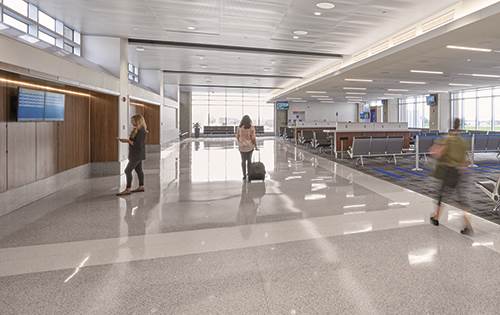When Akron-Canton Airport (CAK) completed a $37 million gate modernization and concourse expansion last fall, the northeast Ohio airport also celebrated the culmination of its 10-year, $115 million capital improvement program. Together, the projects update the 1960s terminal, allow it to accommodate all current aircraft and right size the facility for future growth.
When Akron-Canton Airport (CAK) completed a $37 million gate modernization and concourse expansion last fall, the northeast Ohio airport also celebrated the culmination of its 10-year, $115 million capital improvement program. Together, the projects update the 1960s terminal, allow it to accommodate all current aircraft and right size the facility for future growth.
 Airport President and Chief Executive Officer Ren Camacho explains that CAK was in its heyday when the project was originally conceived more than a decade ago. “We had AirTran, which really started off with a boom here,” says Camacho, noting that the airport hit its peak volume of 1.8 million annual passengers in 2012. Then Southwest Airlines acquired AirTran, and CAK’s passenger numbers started to decline, as Southwest consolidated existing operations to other airports in the region instead of CAK.
Airport President and Chief Executive Officer Ren Camacho explains that CAK was in its heyday when the project was originally conceived more than a decade ago. “We had AirTran, which really started off with a boom here,” says Camacho, noting that the airport hit its peak volume of 1.8 million annual passengers in 2012. Then Southwest Airlines acquired AirTran, and CAK’s passenger numbers started to decline, as Southwest consolidated existing operations to other airports in the region instead of CAK.
Following the downturn in traffic after Southwest’s departure, CAK attracted Allegiant Air and started to see some growth. When Allegiant moved its operation to neighboring Cleveland-Hopkins International Airport, traffic dipped dramatically; but Spirit Airlines established service at CAK and incumbent carriers began backfilling routes. This period of changing carriers, aircraft and markets served made it particularly important for CAK’s expansion plans to remain flexible.
|
facts&figures Project: Gate Modernization & Expansion Location: Akron-Canton (OH) Airport Key Components: 9 gates with boarding bridges; 2-level concourse with 41,600 sq. ft. of space Cost: $37 million Funding: FAA grants; private bonds; state infrastructure bank loans; passenger facility charges Timeline: Aug. 2018-Nov. 2020 Architecture/Design: LEO A DALY; Sol Harris Day Master Plan Lead & Initial Conceptual Planning: CHA Consultants Inc. Civil Engineering/Design: CHA Consultants Inc. General Construction Contractor: Knoch Corp.
Structural Engineering:
Mechanical, Electrical, Plumbing, Fire Protection Engineering:
Geotechnical Investigation: Surveying: Environmental Design Group Cost Estimating: Connico
Environmental Testing: Civil/Sitework Contractor: Great Lakes Construction Apron Underground Detention System: Advanced Drainage Systems Inc. Passenger Boarding Bridges: Ameribridge Services Seating: Arconas Key Benefits: Allows airport to accommodate all narrow-body aircraft at any gate; lays foundation for future growth; new boarding bridges, amenities enhance customer experience |
The airport served about 1 million passengers in 2018 and finished 2019, pre-pandemic, with 830,000 passengers. “But we were having conversations with air carriers—both incumbent and new opportunities—to turn around to get us back to at least 1.2 million by 2021 or 2022,” Camacho advises. “Obviously, the pandemic hit, and it has adversely turned the industry as a whole.”
Despite the downturn, airport officials are optimistic that travelers will return to CAK. And the gate modernization project is designed to make sure that the facilities will be ready. “We wanted to right size the terminal in a way that we could still expand into the future if needed,” Camacho explains.
The airport hired CHA Consulting Inc. to provide conceptual planning for the capital improvement program as a follow-up to the Master Plan update the firm developed for it in 2015.
Paul Puckli, vice president of market development at CHA Consulting, says that airport officials asked the civil engineering firm to present options that would bring the aged terminal up to modern standards. Second-level boarding and eliminating the Y-shaped concourse were among the specific requests. After exploring several options, CAK felt that expanding to the south was the simplest solution, even though it required roadway modifications and finding a new site for some employee parking and the rental car ready/return lot.

The project team spent several months planning the construction phases to reduce operational impacts associated with replacing old gates with new. In the end, reduced passenger levels due to COVID-19 actually made the construction and installation processes easier.
To minimize inconveniences for passengers and the airlines, planners divided the ambitious program into three phases:
- utility and drainage work, plus construction of a 22,900-square-yard concrete aircraft parking apron;
- construction of a 41,600-square-foot, two-level concourse with nine new gates
- demolition of the Y-shaped concourse, allowing 7,500-square-yards of aircraft parking apron.
The Passenger Experience
Improving comfort and amenities for passengers was a primary focus for airport administration. Camacho explains that some of CAK’s infrastructure was challenged to provide many of the modern conveniences travelers expect at today’s airports, holdrooms were undersized and concessions were limited. Additionally, the corridors used to access gates were narrow and boarding occurred on the ramp, which meant passengers were exposed to weather.
The gate modernization project broke ground in August 2018, and crews spent about two years expanding the concourse from 210,000 square feet to 367,000 square feet and installing new boarding bridges at each of the nine gates. Camacho notes that beyond improving conditions for passengers, the new gates allow CAK to accommodate narrow-body aircraft such as 737s at any gate, and position the airport for many years of growth.
The remodeled facility is designed to be modern and timeless, with features that the community wanted, including ample seating to allow for social distancing, abundant power outlets and free Wi-Fi throughout the terminal. Other new conveniences include a business lounge, mothers’ room, children’s play area, sensory room and an indoor pet relief area.

“Ultimately, it comes down to the guest experience,” Camacho remarks. “Whatever we can do to make the experience from the parking lot to the gate as seamless as possible is what we continue to strive for.”

Avery Sarden, vice president and director of operations for project architect/designer LEO A DALY, echoes that sentiment. “Our goal was to design and create an experience that works for the passengers and the owners,” Sarden says. “The airport experience should be part of the fun and enjoyment of travel.”

“On the design side, we have an effective, efficient, aesthetically pleasing facility that seamlessly transforms the existing façade, and goes a long way toward achieving the goal of creating a modern facility and enhancing the passenger experience,” he adds.

A new centrally located concessions area provides additional options and views of the airfield to travelers. In mid-April, many of the retail and food/beverage outlets were still temporarily closed due to the COVID-19 pandemic; but Camacho is confident they will come back stronger than ever. United Concessions Group, of Cleveland, recently took over the concessions program and plans to focus on local food, beverages and merchandise. “We want to make sure that the first and last impression folks have of our airport is as much local as possible,” Camacho explains.
Because CAK was adding new gate and support areas to an existing concourse, designers borrowed from the prevailing aesthetic to create a smooth transition between the two iterations. “As you walk down the concourse, you don’t know where the original ends and the new begins,” reports Dean Schuerman, senior associate/senior project manager at LEO A DALY.
Designers also used a curtainwall to complement the existing façade and improve the overall building aesthetic.
The project team opted for a clearspan design, with no intermediate columns for the full width of the concourse, to keep the facility flexible well into the future. The design also includes space for additional gates. Moreover, major mechanical rooms are located on the lower level to minimize constraints on future modifications of holdroom layouts.
 Schuerman explains that the placement of columns and adjustments to ceiling height intuitively inform passengers how to navigate the space, which becomes more intimate as they move into the holdrooms. A glass façade allows an expansive view of activity on the ramp and contributes to the open feeling of the space. It also connects passengers to the Akron-Canton community outside—a design goal for airport leadership, he adds.
Schuerman explains that the placement of columns and adjustments to ceiling height intuitively inform passengers how to navigate the space, which becomes more intimate as they move into the holdrooms. A glass façade allows an expansive view of activity on the ramp and contributes to the open feeling of the space. It also connects passengers to the Akron-Canton community outside—a design goal for airport leadership, he adds.
Designers updated the concourse’s original electrical system and heating, ventilation and cooling systems to make the facility more energy efficient. New skylights bring in more natural light, and LED fixtures help make the facility more sustainable.
Incorporating art that reflects the community was a priority for Camacho and other CAK executives. One example is a terrazzo floor design in the atrium called Tree of Life. Local artist Lenny Spengler created it to be a timeless piece that contributes to the airport’s sense of place and creates a lasting impression on travelers.
Specifically, Tree of Life includes 46 leaves to commemorate the 1946 inception of CAK. Individual leaves feature important people, places and events that helped shape the Akron-Canton community. Honorees depicted on the leaves were selected for their leadership, social responsibility, mentorship and effective changes to the region.

Looking Ahead
Funding for the $37 million gate modernization program and overall $115 million capital improvement program came from FAA grants, private bonds, state infrastructure bank loans and passenger facility charges. Camacho notes that both support the airport’s focus on community engagement, asset preservation and increasing non-aeronautical revenue such as parking, rental car operations and business development at its two industrial parks. The airport sits on 2,700 acres.
In line with the airport’s master plan, the recent gate modernization project allows for future expansion as passenger demand warrants, with room to add three more gates to the south, two more gates at the north end of the terminal and a centralized baggage inspection system. Such expansion may be necessary once CAK gets back to or exceeds 1.2 million passengers, says Camacho. “We just want to make sure we’re prepared and we’re leaving room to grow.”
He and other airport executives consider the capital programs investments that position CAK for future growth and prosperity. “We are an economic engine in the community and want to ensure we can continue that and improve the quality of life and improve the travel experience for our customers,” Camacho explains. “We exist for the community. We’re an asset to the community, and whatever we can do to ensure a healthy, safe and seamless experience is what we seek for the benefit of the traveling public.



